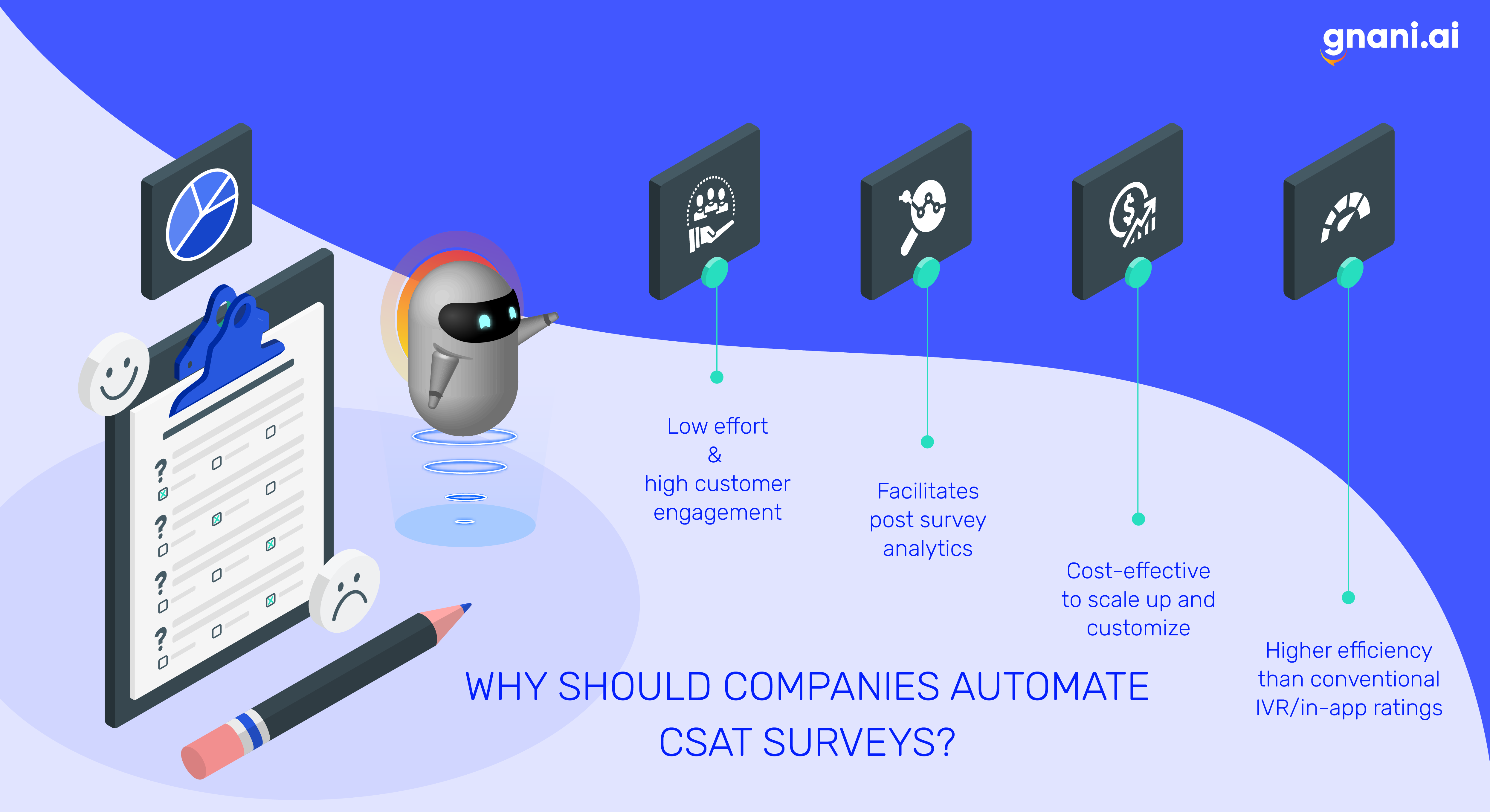Whether a company develops products or provides services, delivery times are speeding up. In this age of competition, not only should customers get their purchases on time, but the customer service experience must also be seamless. This is where the transformational nature of artificial intelligence can be leveraged to drive growth.
Customer satisfaction surveys and feedback are vital aspects of building better products and anticipating customers’ wants and needs to stay ahead of the curve. The traditional ways of gathering customer opinion include while AI-based solutions include voice assistants and in-app surveys etc.
When your company already has a customer satisfaction and feedback collection system in place, here’s what can automation do for you?
Automation for Efficient Communication with Customers
Artificial Intelligence-based automation solves the problem of scaling up highly responsive and efficient customer service. Not only can AI-based voice assistants gather more surveys and feedback, but they can also eliminate the cost of manpower required to process large volumes of customer communications.
In today’s business landscape, customers expect 24/7 omnichannel availability; more so considering that they may be spread out globally. The larger the customer base, the more the expectation of quick turnaround time for responses to their inputs. Voice assistants are easy to integrate across existing customer service channels.
Using AI-based customer support can also deal with the problem of gathering feedback from speakers of different languages and dialects. Voicebots for customers can be trained to mimic human conversations and learn nuances of speech over time. They can also reduce the drop-off rate connected to other forms of CSAT surveys, as people find it quicker to respond via speech than text.
Voice-based survey automation also has proven better response rates than other modes. The deliverability of manual survey collection is suspect but automation can set it up to remain persistent till responses are collected.
A Customer Contact Council study of 75,000 respondents found that customers are more likely to stay loyal when they can get their problems addressed with the least amount of effort. Voicebots for customer support can be trained to sort out complex problems for immediate escalation.
AI for Customer Service Insights
The biggest advantage of automating CSAT and feedback gathering is that the tools come with built-in analytics capability or can be seamlessly integrated with existing systems. Customer feedback produces large volumes of data, rich with actionable insights that can be analyzed much faster using a combination of AI and ML.
AI-based analytics tools can use the data gathered to perform sentiment analysis, text analysis, and feedback review analysis. The common words can be grouped into negative, positive, and neutral sentiments and key metrics like user satisfaction, conversion rate, etc. can be measured. The tools can be trained to pick up on sentiments.
The pattern detection and categorization abilities of AI can be used to derive insights that provide direction to product development and marketing teams. The voice-based system can also be trained to identify common problems to be solved directly without passing them on to a human grievance redressal team. It reduces the potential for human bias in all the above tasks.
Using AI to Improve Customer Experience
While most industries can benefit from using AI to automate customer feedback surveys, large ones that require high volumes of customer engagement stand to benefit the most. The automotive, e-commerce, and ed-tech sectors are just a few names off the top of a long list.
The consumer preference patterns in the automotive sector show that after-sales service is a deciding factor in making consumers return to the brand. Industry leaders like Daimler have made Conversational AI a crucial part of the customer journey, from driving to recording feedback and satisfaction.
However, less than 50% of other players and auxiliary automotive service providers have adopted it. These industries already use IVR systems for automating some aspects of the customer experience. The limitations of these systems such as long messages, too many instructions for customers, etc. can be overcome by deploying conversational AI for the enterprise.
Customers indicate that they are comfortable with Voice Assistants for getting guidance or booking after-sales services and talking about satisfaction. The voice bot can shorten the interaction, retaining customer attention. It offers the same incentive to customers as voice search, communicating needs with minimal effort.
Timing customer surveys and conversations is crucial particularly for industries like e-commerce, where returning users are key to business growth. Feedback and survey bots improve that experience, allowing businesses to get deep insights using customizable dashboards. They are more cost-effective for large-scale surveys and customer engagement drives.
A growing segment that looks to optimize consumer experience is the ed-tech sector. Chatbots are already used in the sales funnel, but there is great potential for survey and feedback voice assistants to streamline consumer engagement in a more satisfactory manner. Ed-tech players need to scale up their after-sales engagement as referrals fuel customer acquisition.
Conclusion
Using Conversational AI for customer engagement frees up human resources to redirect towards tasks requiring more innovation and analysis. Bots can help company agents provide a more streamlined and effective customer satisfaction exchange. AI can help in timing feedback collection to be gathered when the experience is freshest but also the least intrusive.
Never miss an insight! Analyze VoC with the most advanced Conversational AI-based survey solution survey365. Sign up for the demo now!


